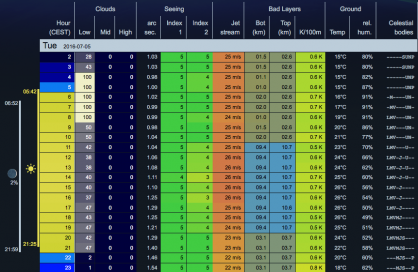With the Astronomy Seeing, meteoblue is building
services for astronomers, meteorologists and other users who depend on a good forecast of sky visibility and
atmospheric conditions during the coming days.
Astronomy Seeing started back in 2005, and has been extended in
June 2009 and again in 2012 with planet phases. It is available for all places in the world free of charge for 3
days, and for 7 days with point+ .
Use instructions and tips

When observing, consider that values may not reflect precisely reality, because of other influencing factors. For good seeing conditions look for dark blue colours in the cloud cover and green values in the Seeing Indices and Jet Stream.
Cloud cover is given for 3 different layers (0-4 km
asl, 4-8 km asl, 8-15 km asl). The coverage is given in percent for the time of display. The percentage integrates
the volume of clouds and density of clouds which are expected to be present. A partial coverage in two layers can
result in the total obstruction of the sky visibility, due to cloud overlap. For high clouds, a partial coverage can
result in a total interception of star visibility. In very high mountains at an altitude above 4000 m asl
(average of the surrounding), the lower cloud layer forecast will be empty and should be ignored, since it is only
relevant for the valley laying below 4000 m.
Fog or very low clouds are not shown here (see pictocast for fog).
Seeing Index 1 and Seeing Index 2 are two different models to calculate the visibility, and are
independent of the cloud cover. These values are computed based on the integration of turbulent layers in the
atmosphere. They only represent the visibility through assumed clear portions of air, and differ in the way of how
the atmospheric density gradients influence the visibility. Seeing 2 gives more weight to the effect of density
fluctuations, and is more likely to indicate air "flickering" due to turbulence. Seeing does NOT include the cloud
cover. It is possible that no observation is possible with a seeing index of "5", if cloud cover is 100%.
Conversely, it is possible that there is no cloud cover 0% (and all stars are "visible"), but observation is
severely reduced by low seeing index ("1"), due to air turbulence.
Note: There are 2 reasons for not including
the cloud cover in the seeing index calculation: 1. Seeing is a state of the air - it is therefore independent of
cloud cover. 2. Sometimes, clouds are sparse, and then observations can be made between clouds. In this case, it
would be very difficult to set a "limit" for cloud cover which influences the Seeing Index and satisfies all users.
Arcsecond is a unit of angular measurement equal to 1⁄3,600 of a degree, or 1⁄1,296,000 of a circle.
Arcsecond can be used to estimate the minimal size of an object which is still visible using telescope aimed at the
open sky, expressed as an angle. The arcsecond measures shown are based on "Seeing 1", "Seeing 2" and "Bad layers",
and do therefore not directly correlate with each weather variable.
Basic information about calculation (in French).
High Jet stream speeds (>35m/s) usually correspond to bad seeing, as well as very low speeds
(<5m/s).
Bad layers are the atmosphere layers in which turbulence is producing disturbance of air and
particles, and thereby influencing the astronomical "Seeing". Bad layers have a temperature gradient > 0.5K/100m.
The actual gradient is shown in K/100m. The top and bottom height of the bad layers is indicated by bad layers
bot/top.
Visible planets and coordinates also consider temperature profiles of the atmosphere. The following planets are available: MVMJSUNP => Mercury, Venus, Mars, Jupiter, Saturn, Uranus, Neptune and Pluto. If you move your courser over the visible planets column, hourly coordinates for each planet will appear: Azimuth (Az) from north with altitude in degree (Alt) onto horizon, right ascension (RA) and declination (DEC). We may consider adding 10 minutes coordinates and additional objects on request.



